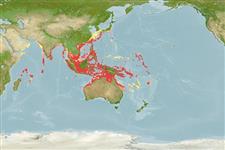>
Eupercaria/misc (Various families in series Eupercaria) >
Lutjanidae (Snappers) > Lutjaninae
Etymology: Lutjanus: Malay, ikan lutjan, name of a fish.
More on authors: Quoy & Gaimard.
Environment: milieu / climate zone / depth range / distribution range
Ecologia
marinhas; estuarina associadas(os) a recifes; intervalo de profundidade 10 - 72 m (Ref. 9710). Tropical; 35°N - 26°S, 50°E - 180°E (Ref. 55)
Indo-West Pacific: Seychelles, then southern India to New Caledonia and Gilbert Islands, extending northward to the Ryukyu Islands Replaced by Lutjanus ophuysenii from southeastern China and Taiwan to southern Korea and Japan (Ref. 37816).
Comprimento de primeira maturação / Tamanho / Peso / Idade
Maturity: Lm 15.4, range 14 - 22 cm
Max length : 40.0 cm TL macho/indeterminado; (Ref. 55); common length : 35.0 cm TL macho/indeterminado; (Ref. 5450); idade máx. registrada: 12 anos (Ref. 37970)
Espinhos dorsais (total): 10; Raios dorsais (total): 12-14; Espinhos anais 3; Raios anais : 8 - 9. Dorsal profile of head moderately sloped. Preorbital width about equal to eye diameter. Preopercular notch and knob poorly developed. Scale rows on back rising obliquely above lateral line. Generally whitish or pink with a yellowish brown to black stripe on the middle of the side. Juveniles and sub-adults with an intensely black mid-lateral stripe and an oval black spot, eye-sized or greater, lying in the middle of the stripe below last dorsal spines. Adults with yellow median fins (Ref. 48635). Body depth 2.6-3.0 in SL (Ref. 90102).
Adults are found in the vicinity of coral reefs, also areas with flat bottoms and occasional low coral outcrops, sponges, and sea whips. They occur singly or in groups of up to about 30 individuals. Feed on fishes, shrimps, crabs and other benthic invertebrates.
Sex ratio differed significantly from 1:1 above 30 cm fork length (Ref. 4840). Larvae grow at a rate of 1.2 to 1.7 mm per day during the first 1 or 2 months.
Allen, G.R., 1985. FAO Species Catalogue. Vol. 6. Snappers of the world. An annotated and illustrated catalogue of lutjanid species known to date. FAO Fish. Synop. 125(6):208 p. Rome: FAO. (Ref. 55)
Status na Lista Vermelha da UICN (Ref. 130435)
Ameaça para os humanos
Harmless
Uso pelos humanos
Pescarias: espécies comerciais; Aquário: Aquários públicos
Ferramentas
Relatórios especiais
Baixar XML
Fontes da internet
Estimates based on models
Preferred temperature (Ref.
123201): 25.1 - 29.1, mean 28.2 °C (based on 1040 cells).
Índice de diversidade filogenética (Ref.
82804): PD
50 = 0.5000 [Uniqueness, from 0.5 = low to 2.0 = high].
Bayesian length-weight: a=0.01479 (0.01292 - 0.01693), b=2.97 (2.94 - 3.00), in cm total length, based on LWR estimates for this species (Ref.
93245).
Nível Trófico (Ref.
69278): 4.0 ±0.3 se; based on diet studies.
Generation time: 3.7 (1.6 - 4.3) years. Estimated as median ln(3)/K based on 10
growth studies.
Resiliência (Ref.
120179): médio(a), tempo mínimo de duplicação da população 1,4 - 4,4 anos (K=0.22-0.70; tmax=12).
Fishing Vulnerability (Ref.
59153): Low vulnerability (23 of 100).
Nutrients (Ref.
124155): Calcium = 34.4 [22.4, 47.9] mg/100g; Iron = 0.308 [0.202, 0.482] mg/100g; Protein = 18.7 [17.2, 20.0] %; Omega3 = 0.149 [0.112, 0.200] g/100g; Selenium = 53 [35, 81] μg/100g; VitaminA = 173 [32, 622] μg/100g; Zinc = 0.549 [0.441, 0.738] mg/100g (wet weight); based on
nutrient studies.
